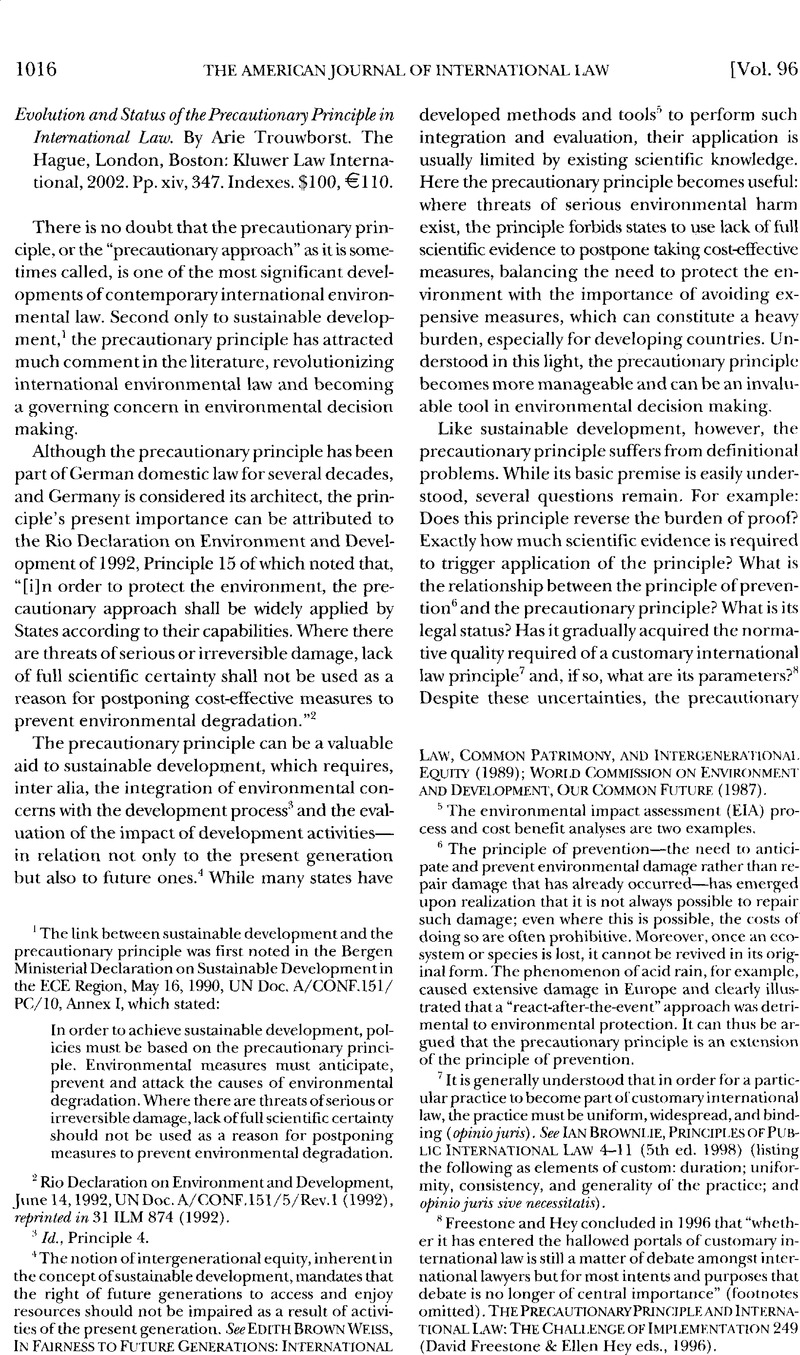Article contents
Evolution and Status of the Precautionary Principle in International Law. By Arie Trouwborst. The Hague, London, Boston: Kluwer Law International, 2002. Pp. xiv, 347. Indexes. $100, €110.
Published online by Cambridge University Press: 27 February 2017
Abstract

- Type
- Recent Books on International Law
- Information
- Copyright
- Copyright © American Society of International Law 2002
References
1 The link between sustainable development and the precautionary principle was first noted in the Bergen Ministerial Declaration on Sustainable Development in the ECE Region, May 16, 1990, UN Doc. A/CONF.151/ PC/10, Annex I, which stated:
In order to achieve sustainable development, policies must be based on the precautionary principle. Environmental measures must anticipate, prevent and attack the causes of environmental degradation. Where there are threats of serious or irreversible damage, lack of full scientific certainty should not be used as a reason for postponing measures to prevent environmental degradation.
2 Rio Declaration on Environment and Development, June 14,1992,UNDoc.A/CONF.151/5/Rev.l (1992), reprinted in 31 ILM 874 (1992).
3 Id., Principle 4.
4 The notion of intergenerational equity, inherent in the concept of sustainable development, mandates that the right of future generations to access and enjoy resources should not be impaired as a result of activities of the present generation. See Edith Brown Weiss, In Fairness to Future Generations: International Law, Common Patrimony, and Intergenerational Equity (1989); World Commission on Environment and Development, Our Common Future (1987).
5 The environmental impact assessment (EIA) process and cost benefit analyses are two examples.
6 The principle of prevention—the need to anticipate and prevent environmental damage rather than Repair damage that has already occurred—has emerged upon realization that it is not always possible to Repair such damage; even where this is possible, the costs of doing so are often prohibitive. Moreover, once an ecosystem or species is lost, it cannot be revived in its original form. The phenomenon of acid rain, for example, caused extensive damage in Europe and clearly illustrated that a “react-after-the-event” approach was detrimental to environmental protection. It can thus be argued that the precautionary principle is an extension of the principle of prevention.
7 It is generally understood that in order for a particular practice to become part of customary international law, the practice must be uniform, widespread, and binding (opiniojuris). See Brownlie, Ian, Principles of Public International Law 4-11 (5th ed. 1998)Google Scholar (listing the following as elements of custom: duration; uniformity, consistency, and generality of the practice; and opinio juris sive necessitatis).
8 Freestone and Hey concluded in 1996 that “whether it has entered the hallowed portals of customary international law is still a matter of debate amongst international lawyers but for most intents and purposes that debate is no longer of central importance” (footnotes omitted). The Precautionary Principle and International Law: The Challenge of Implementation 249 (Freestone, David & Hey, Ellen eds., 1996)Google Scholar.
9 See, e.g., United Nations Framework Convention on Climate Change (FCCC), May 9,1992,31 ILM 849 (1992), available at <http://unfccc.int/>; Convention on Biological Diversity, June 5, 1992, 31 ILM 818 (1992); Kyoto Protocol to the FCCC, Dec. 10,1997, 37 ILM 22 (1998), available at <http://www.cop4.org/kp/kp.html>; Cartagena Protocol on Biosafety to the Convention on Biological Diversity, Jan. 29, 2000, 39 ILM 1027 (2000), available at <http://www.biodiv.org>; Stockholm Convention on Persistent Organic Pollutants, May 22,2001, 40 ILM 532 (2001), available at <http://www.pops.int/ document/convtext/convtext_en.pdf>.
10 See International Law and Global Climate Change 23-30 (Robin Churchill & David Freestone eds., 1991) for a discussion of the evolution of the precautionary principle.
11 Preceding books on the same topic in the series are Harald Hohmann, Precautionary Legal duties and Principles of Modern International Environmental Law (1994) and The Precautionary Principle and International Law, supra note 8.
12 Also called the principle of prevention. See supra note 6. The main distinction between this principle and Principle 21 is that the latter applies only in the context of transboundary pollution issues (or harm to global commons), while the former is less limited. It can be argued that the EIA process seeks to give effect to the principle of prevention (and, of course, in relation to transboundary pollution), but the precautionary principle is wider in its application, as it compels action even in the absence of solid scientific proof of environmental harm.
13 See Patricia, W. Birnie & Alan, E. Boyle, International Law and the Environment 110 (2d ed. 2002)Google Scholar; Kiss, Alexandre & Shelton, Dinah, International Environmental Law 62 (2000)Google Scholar.
14 For example, although Trouwborst uses Article 206 of the 1982 Law of the Sea Convention as an example of the precautionary principle, it actually relates to the EIA process.
15 In addition, Colombia and Mexico are briefly mentioned. Of the countries with economies in transition, the Czech Republic, Slovakia, and Hungary are briefly discussed.
16 See the extensive discussion of environmental protection in ancient civilizations, including that of Sri Lanka (Ceylon), by Justice Weeramantry in his separate opinion in Gabčíkovo Nagymaros Project (Hung./Slovk.), 1997 ICJ Rep. 7 (Sept. 25), reprinted in 37 ILM 162 (1998).
- 1
- Cited by


